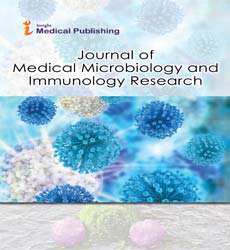ISSN : 2634-7164
Journal of Medical Microbiology and Immunology Research
Plasma Cell Advances in Health and Various Disease
Department of Microbiology and Infection Control, Akershus University Hospital, Lørenskog, Norway
- Corresponding Author:
- Nick Leegaard
Department of Microbiology and Infection Control
Akershus University Hospital, Lørenskog, Norway
E-mail: tleenick@ahus.no
Received Date: November 04, 2021; Accepted Date: November 18, 2021; Published Date: November 26, 2021
Citation: Leegaard N (2021) Plasma Cell Advances in Health and Disease. J Med Microbiol Immunol Res Vol.4 No.2:21
Copyright: © 2021 Leegaard N. This is an open-access article distributed under the terms of the Creative Commons Attribution License, which permits unrestricted use, distribution, and reproduction in any medium, provided the original author and source are credited.
Introduction
The Plasma Cell (PC) is a relatively new cell type in biomedical science, with functional identification dating only from the midtwentieth century. PCs are terminally differentiated immune effectors that emerge from B cells after infection and vaccination and have the highly specialized function of producing and secreting antibodies, which are the effector molecules of humoral immunity. Circulatory antibodies can survive in the absence of antigen and give lifetime protection, allowing for serological memory [1]. PCs have long been assumed to be short-lived and to maintain serum antibodies via ongoing differentiation from B cells due to their quick departure in the circulation. It hasrecently been discovered that PCs can live and manufacture protective antibodies for decades after being exposed to an antigen. The nature of the stimulus that initiates PC creation from short-lived Antibody Secreting Cells (ASC) and the molecular processes that underpin such change remain unknown. Long-lived PCs (LLPCs) survive in specific habitats, mostly in the Bone Marrow (BM).
PC survival niches are formed by the interaction of several cell types and signals. In humans, the LLPC phenotype is presently characterized as CD19negCD138+ CD38hi, although phenotypic, biochemical, and functional variability within this group are probable. LLPCs, far from being dormant, exhibit unparalleled Immunoglobulin (Ig) secretion, which necessitates unique organelle structure as well as adaptive proteostatic and metabolic characteristics that arouse significant interest and provide formidable research difficulties. The lifespan of PCs, from creation to maintenance, is dependent on a number of variables, the discovery and mechanistic details of which are essential for furthering our understanding of adaptive immunity as well as the pathophysiology of PC-mediated autoimmune and neoplastic diseases [2]. This collection focuses on basic processes of PC lifespan in health and illness, including as multiple myeloma and allergies, as well as new PC functions and immunophenotypesin nonhuman primates. Some studies explored the processes explaining how the structural biology of multivalent antigens might generate long lasting protective immunity in LLPCs as compared to monovalent antigens, a topic whose importance for vaccine design has been highlighted by the SARS-CoV-2 pandemic. An overview of the dynamic nature of PC niches, current information on their molecular and cellular makeup, and how changes in these components may impact PC performance, with a particular focus on metabolism and emerging tools to measure it in-vivo over time. Some researchers investigated the extrinsic and intrinsic variables influencing PC lifespan inside their niche, such as continuous niche-generatedsignalsspecific to LLPCsurvival, metabolic fitness, particular bioenergetics cues, and cellular components of the LLPC niche itself. It depicts a historical viewpoint on PC discovery and characterization [3].
Because LLPCs may produce antibodies indefinitely, regardless of antigen presence, T cell assistance, or precursor availability, they recommend naming them memory PCs. Because PCs live longer in inflamed tissues, they examine the inflammatory cellular and molecular mechanisms that are hypothesized to support PC life. The molecular, functional, and immunophenotypic characteristics that distinguish the transformation of human short-lived ASCs to LLPCs, as well as the known cell-autonomous and non-autonomous factors required, with a focus on the adaptive significance of the changes induced to early minted ASCs as they mature into late BM LLPCs. They suggest a minimum combination of extrinsic circumstances, including secreted proteins from BM stromal cells, APRIL, and low oxygen tension, as an experimental human BM mimic capable of retaining human ASCs in culture for weeks for molecular ex vivo investigations. Not all PCs are safeguarded.
Pathogenic PCs in human illness can occur from abnormal PC production and maintenance, such as PC dyscrasias, in which altered PCs gain increased proliferation and survival. Numerous myelomas is the classic PC cancer, characterized by the clonal proliferation of PCs at multiple foci in the BM, often resulting in lytic bone lesions, hyperkalaemia, renal failure, anaemia, and infections. Myeloma cells are the cancerous equivalent of BM resident LLPCs; however, the precise cell of genesis of this malignancy is unclear. Myeloma cells hijack BM niche-specific pro-survival signals meant for LLPCs [4]. Targeting such multi- cellular environmental niches has significant therapeutic promise against myeloma, but additional research is needed to acquire a complete and translatable understanding of the underlying circuits. Some researchers discussed the cellular and genetic origins of multiple myeloma, reconstructing landmark discoveries on clonal gammopathies and their interconnectedness with advancing knowledge of PCs, with an in-depth focus on myeloma- driving genetic and epigenetic alterations in the context of PC differentiation and biology.
References
- Fagraeus A (1947) Plasma cellular reaction and its relation to the formation of antibodies in vitro. Nature 159: 499.
- Cooper MD, Peterson RD, Good RA (1965) Delineation of the thymic and bursal lymphoid systems in the chicken. Nature 205:143–146.
- Manz RA, Thiel A, Radbruch A (1997) Lifetime of plasma cells in the bone marrow. Nature 388: 133–134.
- Slifka MK, Antia R, Whitmire JK, Ahmed R (1998) Humoral immunity due to long-lived plasma cells. Immunity 8: 363–372.
Open Access Journals
- Aquaculture & Veterinary Science
- Chemistry & Chemical Sciences
- Clinical Sciences
- Engineering
- General Science
- Genetics & Molecular Biology
- Health Care & Nursing
- Immunology & Microbiology
- Materials Science
- Mathematics & Physics
- Medical Sciences
- Neurology & Psychiatry
- Oncology & Cancer Science
- Pharmaceutical Sciences
